How to Write a Course That Will Hook Learners: Two Simple eLearning Writing Techniques

Let’s say you’ve created a training course and put it online. You run a report on your course a few days later and discover that nobody has opened it. Then you send a personal reminder to each student, emphasizing the importance of the content — and still get only a few views. So what’s wrong with your content? Chances are the issue is poor writing.
Now how to write an online course that will be both interesting and useful for the learner? Good eLearning writing includes two aspects: writing a captivating title to entice the learner to open the course, and laying out the subject clearly to keep them engaged. In this article, we will cover both aspects with two simple eLearning writing techniques.
Prefer to watch your content on eLearning trends and best practices? We’ve got you, with a short summary of this post from Polina:
The Title: Addressing Learners’ Pain Points to Spark Interest
The reason companies are creating online courses is that they need to train their employees on loads of important things quickly: from workplace safety to product updates and sales methods. All these aspects are important for a business, but such things rarely engage employees — especially if they’re struggling with a heavy workload or project deadlines.
Here are a few examples of boring, but necessary topics:
- “Warehouse Safety Rules”
- “Digital Transformation: Trends and Challenges”
- “Sales Techniques 101: General Principles of Working With Clients”
Each of the topics listed above conveys something that is important to the business and therefore must be learned by all employees.
The trick is that you can’t make people learn something. If you want them to invest their time and effort and truly immerse themselves in the content, you need to inspire and motivate them to do so.
The course title should promise the learner a concrete solution to their problem
Learners will be far more interested in taking the course if it promises to resolve their pain points. Therefore, the topic of the course should clearly state why this content is worth exploring and how it can make learners’ lives easier.
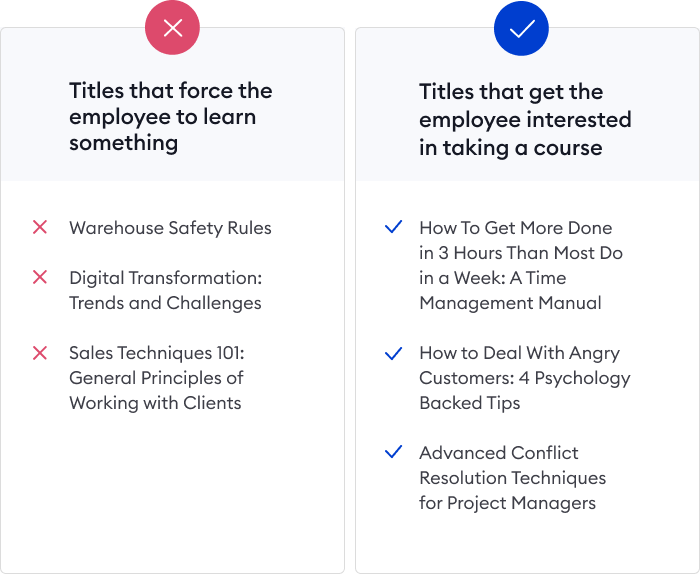
How can you tell if a topic is sufficiently motivational to the employee? Here’s a simple test: ask yourself if the employee has this issue on their mind when they wake up in the morning. It’s rare that a person will think about warehouse safety while sipping their morning cup of coffee. But if they’re struggling with a conflict in their team, it hardly leaves their mind — even outside the office.
The course topic shouldn’t simply promise the reader a benefit but correlate with the specific problem they are trying to solve.
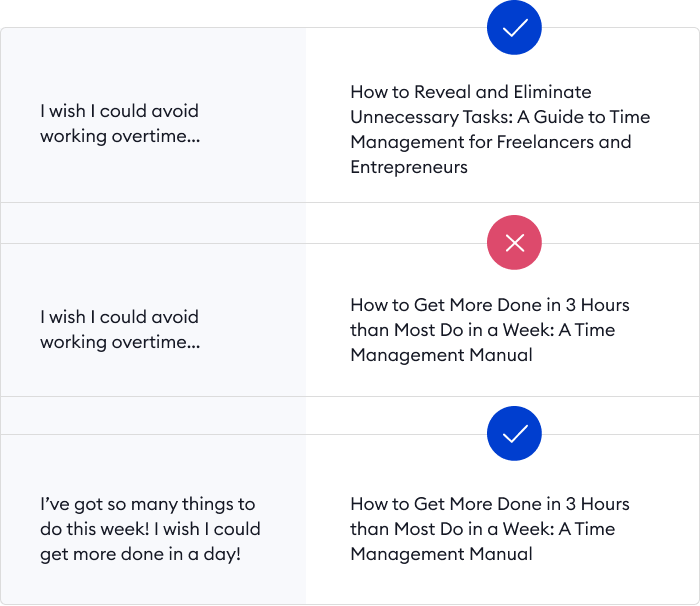
To find out what bothers employees, immerse yourself in their environment: communicate in person, listen to conversations in the corridors, and read chats and forum posts.
Apart from telling the learner how the course will be useful for them, the title also gives the course a specific orientation. For example, when you present the course as a guide for beginners, you assign the learner a certain role.
The trick is to make the learner feel that the course will help them become a better version of themselves.
Let the reader feel that the course will make them a better version of themselves
Avoid intimidating the learner by referring to them as a dummy, disorganized, mediocre specialist, etc. Instead, make them believe that they are smart and successful if they are about to take your course. Here are a few examples:
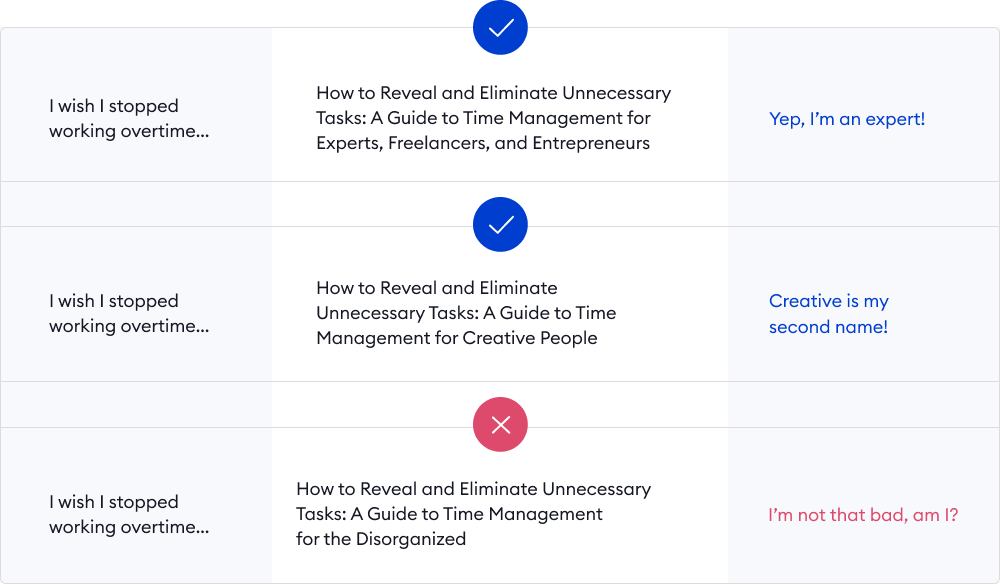
Once you come up with the course title, ask yourself two simple questions:
- Did the learner wake up with this idea in mind?
- Does this title make them believe they are (or will be) smart and successful?
If you answered “yes” to both questions, chances are your course title will grasp a learner’s attention.
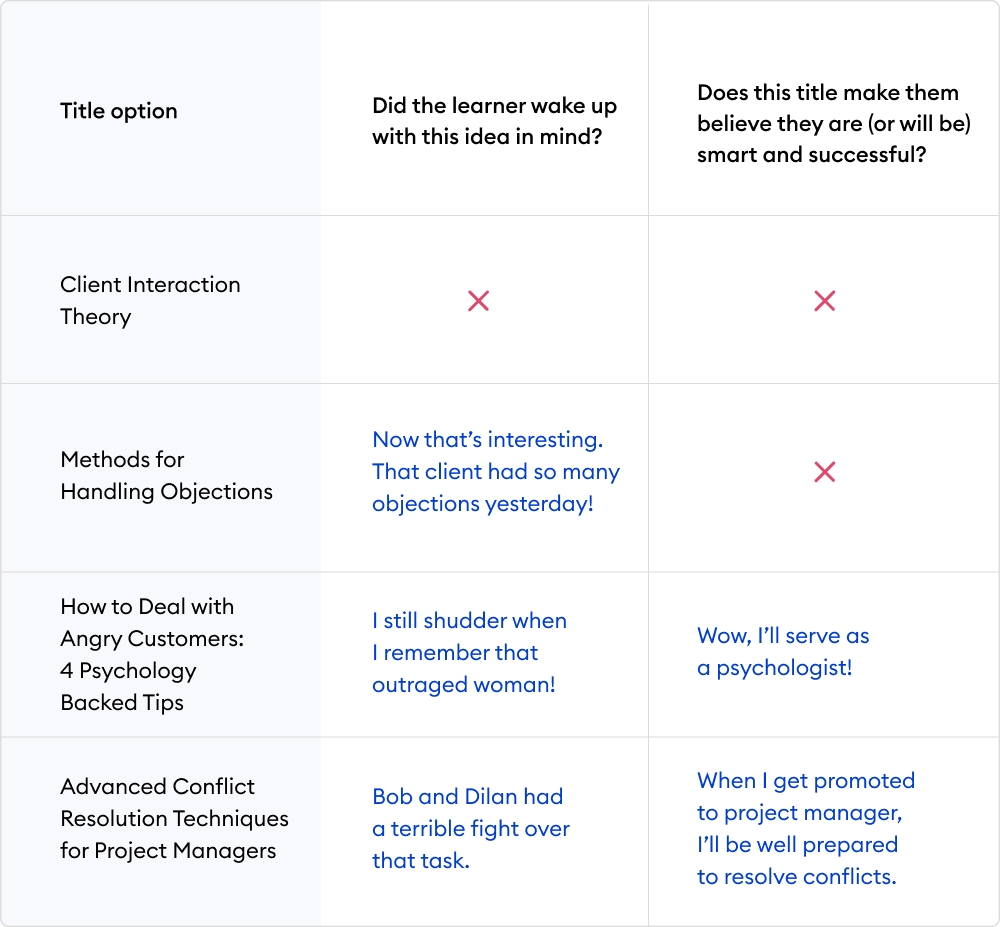
If your course is industry-specific, it is also a good idea to make this clear in the title. This way, the course will look even more relevant to people in that industry.
For example, the course title “Advanced Techniques for Handling Objections When Selling Smartphones” will immediately attract the attention of digital equipment salespeople.
The information itself may be quite generic (because the same sales principles work in most areas), but the fact that the title is personalized will definitely spark the interest of the target audience.
The Message: Using Examples to Stimulate Behavior Change
Now that you’ve gotten their attention, the goal is to keep them engaged. Learners often quit a course because the content seems difficult to understand and irrelevant to their life.
On the other hand, when the content is crystal clear, it becomes easy for them to apply knowledge. The key to making your writing clear and understandable is giving a lot of examples.
To convey the idea, give examples and show possible outcomes
Let’s say you’re writing a course for sales reps. You give learners one simple piece of advice:
“It is important to be in a good mood when communicating with a client.”
In theory, this idea is clear and useful, but in practice, it is very difficult to maintain a good mood – especially when dealing with a difficult client. This advice won’t trigger any change in behavior.
But if you enhance this abstract idea with a couple of examples to illustrate possible outcomes, it immediately becomes a practical technique that sales reps can apply to their work.
Here’s how it works:
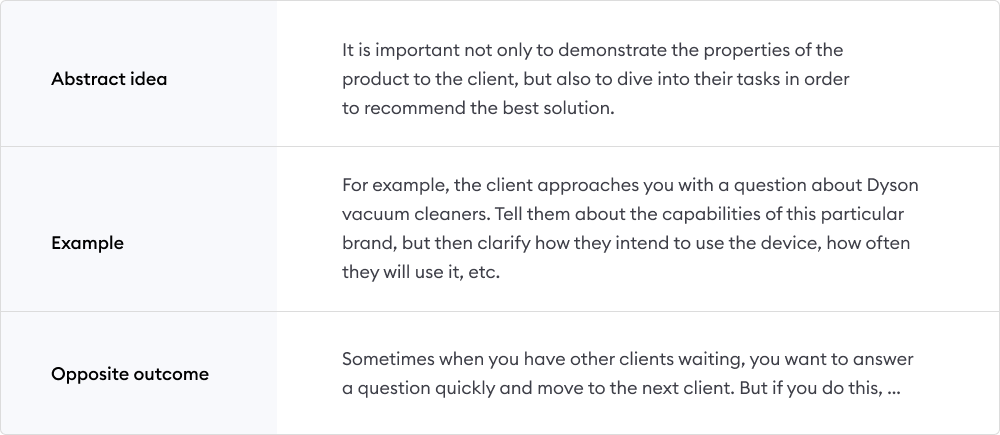
When an abstract idea is supported by an example and an opposite outcome, it gives the learner a clear understanding of the situation and possible consequences.
To make your examples as descriptive as possible, avoid using the passive voice. When there’s a character in the sentence, and this character acts in a certain way, it always paints a picture.
Once a learner has looked at the situation from several angles, they gain a deeper understanding of the topic and are prepared to handle similar situations in real life.
Giving many examples often makes your course longer, but if they are written in the active voice, they are usually easy to read or scan.
Also read: → best e-learning examples to inspire you
To Wrap Up
In order to write an online training course that will hook learners at first sight, follow these simple rules:
- Address the reader’s pain points in the title to motivate them to take the course.
- Make sure the title makes the learner feel smart and successful.
- Stimulate behavior change by giving concrete examples and describing possible outcomes.




